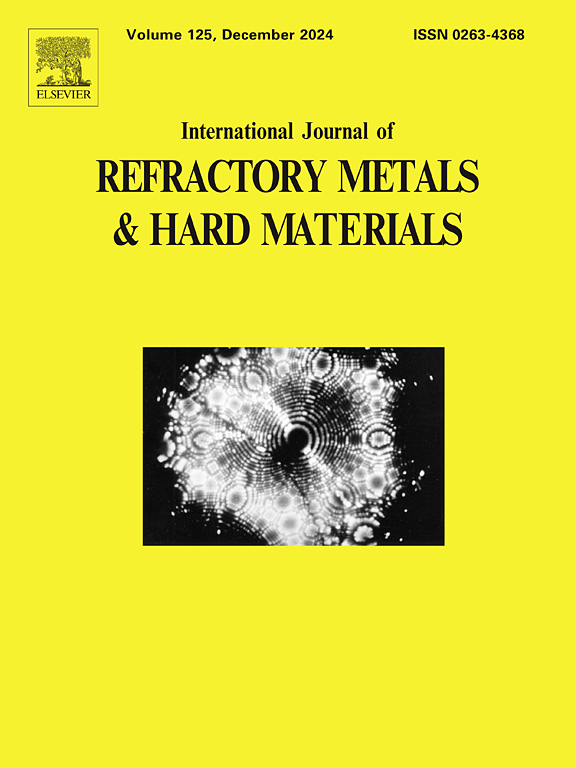Temperature-driven wear behavior of WC/Co against Si3N4 exposed to air conditions
IF 4.2
2区 材料科学
Q2 MATERIALS SCIENCE, MULTIDISCIPLINARY
International Journal of Refractory Metals & Hard Materials
Pub Date : 2025-07-21
DOI:10.1016/j.ijrmhm.2025.107342
引用次数: 0
Abstract
WC/Co coatings are indispensable wear-resistance material to withstand harsh environments in aerospace engines and power generation turbines. This study systematically investigates the reciprocating wear behavior of high-velocity oxygen-fuel (HVOF) sprayed WC/Co coatings against Si₃N₄ counterparts across temperatures ranging from 25 °C to 800 °C in ambient air. The WC/Co-Si3N4 tribo-pair displays relatively constant friction and desirable wear resistance at RT and 400 °C, nevertheless friction rises, and wear deterioration occurs for the WC/Co-Si3N4 tribo-pair as temperature exceeds 500 °C. The friction coefficient rises from 0.38 ± 0.03 at 25 °C to 0.68 ± 0.05 at 600 °C, peaking at 0.83 ± 0.07 at 800 °C, while the specific wear rate of WC/Co escalates exponentially from 2.1 × 10−7 mm3/Nm at 25 °C to 1.4 × 10−4 mm3/Nm at 800 °C, representing a three-order-of-magnitude increase from RT to 800 °C. X-ray diffraction (XRD) and Raman spectroscopy confirm the formation of tribo-oxidized products. At higher temperatures, though the in-situ formation of tribo-chemically oxidized products initially helps to suppress wear to some extent, 600 °C as the critical threshold for stable tribological performance, beyond which contact fatigue and oxidative wear dominates. WC/Co coating demonstrates the temperature stimulated wear worsening phenomenon, which relates to the interfacial tribochemistry during friction. Resulting WO3 layer on WC/Co coating rubbed against SiO2 of Si3N4 counterpart substantially undermines the tribological compatibility and thereby poor wear resistance.
空气条件下WC/Co对Si3N4的温度驱动磨损行为
WC/Co涂层是航空发动机和发电涡轮机中不可缺少的耐恶劣环境的耐磨材料。该研究系统地研究了高速氧燃料(HVOF)喷涂WC/Co涂层在25°C到800°C的环境空气中对Si₃N₄对应物的往复磨损行为。WC/Co-Si3N4摩擦副在室温和400℃时表现出相对恒定的摩擦和良好的耐磨性,但当温度超过500℃时,WC/Co-Si3N4摩擦副的摩擦升高,磨损恶化。摩擦系数从25℃时的0.38±0.03上升到600℃时的0.68±0.05,在800℃时达到峰值0.83±0.07,而WC/Co的比磨损率从25℃时的2.1 × 10−7 mm3/Nm上升到800℃时的1.4 × 10−4 mm3/Nm,从RT到800℃增加了三个数量级。x射线衍射(XRD)和拉曼光谱证实了摩擦氧化产物的形成。在较高温度下,虽然原位形成的摩擦化学氧化产物最初有助于在一定程度上抑制磨损,但600℃是稳定摩擦学性能的临界阈值,超过600℃,接触疲劳和氧化磨损占主导地位。WC/Co涂层表现出温度刺激磨损加剧现象,这与摩擦过程中的界面摩擦化学有关。WC/Co涂层上的WO3层与Si3N4涂层的SiO2发生摩擦,大大破坏了涂层的摩擦学相容性,从而导致涂层的耐磨性差。
本文章由计算机程序翻译,如有差异,请以英文原文为准。
求助全文
约1分钟内获得全文
求助全文
来源期刊
CiteScore
7.00
自引率
13.90%
发文量
236
审稿时长
35 days
期刊介绍:
The International Journal of Refractory Metals and Hard Materials (IJRMHM) publishes original research articles concerned with all aspects of refractory metals and hard materials. Refractory metals are defined as metals with melting points higher than 1800 °C. These are tungsten, molybdenum, chromium, tantalum, niobium, hafnium, and rhenium, as well as many compounds and alloys based thereupon. Hard materials that are included in the scope of this journal are defined as materials with hardness values higher than 1000 kg/mm2, primarily intended for applications as manufacturing tools or wear resistant components in mechanical systems. Thus they encompass carbides, nitrides and borides of metals, and related compounds. A special focus of this journal is put on the family of hardmetals, which is also known as cemented tungsten carbide, and cermets which are based on titanium carbide and carbonitrides with or without a metal binder. Ceramics and superhard materials including diamond and cubic boron nitride may also be accepted provided the subject material is presented as hard materials as defined above.

 求助内容:
求助内容: 应助结果提醒方式:
应助结果提醒方式:


